MUTEMUSE X KIMI&12
STORY


Journey & Still Life by Kimi&12
INTERVIEW
Drawings of Kimi&12 have stories, and they don’t end on dull conclusions. The retro colors may seem familiar at first glance, but we are drawn to the captured moments in the strange context of a peculiar scenery.
They say true humor comes not from popular memes, nor physical improves, but from context; Kimi&12 may be natural born humorists when it comes to comfortable, natural jokes. We’re talking about the ones that seem rather pointless but give you a faint smile after a while.
The collaboration with MUTEMUSE is somewhat similar. Kimi&12's <Still Life> and <Journey> designed for MUTEMUSE are mysterious in a way, by some means engaging the viewers into a conversation.
We sat down with 'Kimi' (Kim Hee-eun) and '12' (Kim Dae-il) of Studio Kimi&12, unique in their own language of design through imaginative sensibility and inquisitive use of colors.
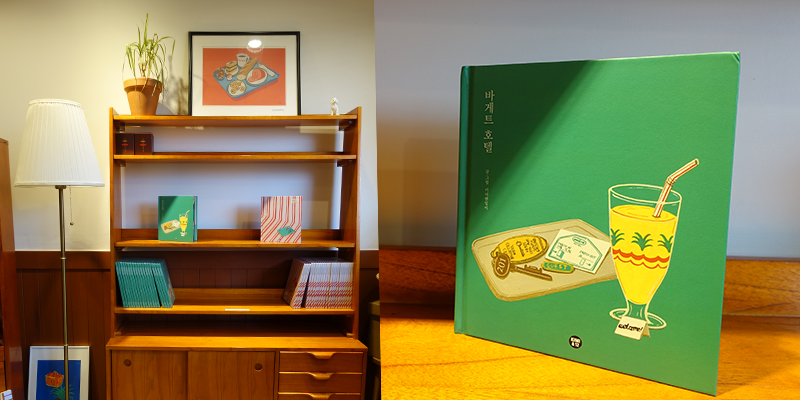
# Les Baguettes Hotel
- <Les Baguettes Hotel> is the most representative work by Kimi&12. It's interesting that it's a children's book.
- Children's book may just be for children, but <Les Baguettes Hotel> is closer to a picture book for grown-ups and children alike. I illustrated the place I wanted to visit; nothing unnatural, but in the hopes of fulfilling my own desires.
- The book features a range of peculiar characters, such as the mysterious guest on extended stay and the concierge who stamps check-ins all day. Because these characters are so interesting, people seemed to be naturally drawn to their stories as well.
- Possibly. The Baguettes Hotel for us is a place for somewhat peculiar individuals, where you can imagine various things happening around them. There are always those who are ‘harmless, yet somewhat peculiar’. I thought it would be fun to draw those who may not be mighty heroes, but are not ordinary individuals either. <Les Baguettes Hotel> is where these people and stories are gathered together.
- "Harmless, yet somewhat peculiar..."reminds me of you two.
- ...(laughs)
- Kimi&12 is a brand of its own. What do you feel is the most important aspect of a brand?
- Persistence seems to be key. We wavered a bit in the beginning because we wanted to do everything we found adorable. Yet things don't work that way. We kept on trimming and weeding out our ideas to something solid. Still having to adhere to the consumers' taste, we try to find that middle ground between what we like and what the consumers want.
- Sometimes, your favorite works seem to differ from what others like most.
- All the time. Either way is fine, as long as someone likes them. So, at times, we tend to consider the popular taste over our own.
- Then which work actually reflects your style the most?
- <Les Baguettes Hotel> products. It was a project we wanted to do in the first place. Each product is nothing fancy, but the story ties them together. It's satisfying because you get the feeling you’re at Les Baguettes Hotel even with a few products.
- Your works have that retro vibe with a sense of uncanniness.
- We were into the idea of retro and vintage styles and grew to really like retro. 'Vintage' implies aged or old, but the idea of 'retro' seems to allude to a broader culture or spirit.
- Looks like your lifestyles reflect all of this as well- you exchange hand-written letters and even use 2G phones.
- It's something we both like and try our best to maintain. For instance, the internet is flooded with information. It's important to develop the ability to distinguish between what is real and fake. Whenever there's an issue, we try to discuss our thoughts before scrolling through the comments. Regardless of being right or wrong, this allows us to practice organizing our thoughts and forming judgements based on our own standards.
- So where do you draw inspiration for your work?
- We talk to each other a lot. Inspiration comes from the most random moments. For instance, most of the photos we take when we travel are of peculiar color combinations rather than the scenery. People would question, 'Why would anyone take these photos?' They're random yet surprising arrangements … like the ones we saw in Okinawa.
- Some of your works are reminiscent of David Hockney or Edward Hopper: the lively colors, somewhat static use of light and shadow, unfathomable characters...
- I'm honored. David Hockney, Edward Hopper and Henri Matisse are some of our favorites who we look up to.
- You have more than seventy-thousand followers on Instagram. How does it make you feel when others comment on your work or interviews?
- Let’s see...How much do they know? What have I been going around and saying? (laughs)
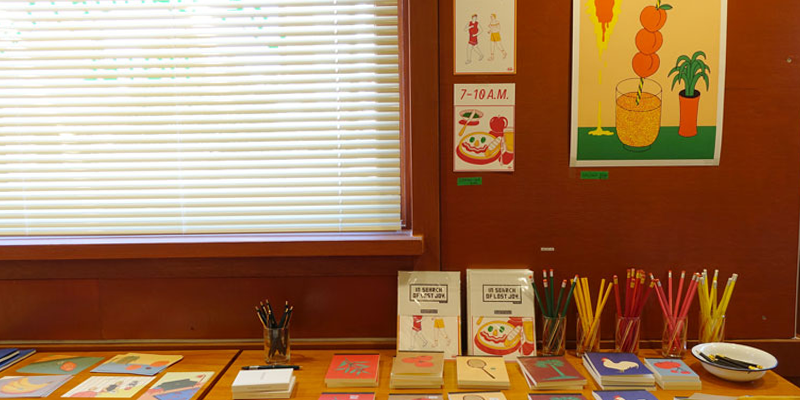
# ‘KIMI’ & ‘12’
- What did you originally study?
- Kimi : I loved to draw, but for some reason I ended up studying French literature. When I turned 21, my first overseas trip was to France. Since I wasn’t fluent in French, I was only able to browse through picture books at bookstores. This made me want to draw again, so I started taking drawing classes as soon as I returned home. I haven't looked back since.
12 : My parents ran a garment factory. My mom did the design while my dad handled the wholesale distribution. Growing up, I always thought ‘that's what I want to do.’ It wasn't until my senior year in high school, that I first learned one could major in design. However, it was already pretty late in the application process, so I ended up majoring in fashion design. But I was already familiar with the textiles and materials, so the curriculum didn't interest me. I struggled to fit in, dropped out, moved to Seoul, and began working in visual design.
- From a publication event to the Baguette Hotel in Namhae, it seems like you're also interested in spatial design.
- It's something we wanted to do since the very beginning. We had an opportunity to open a small publication event in Busan. Seeing something we had been putting off for so long due to various circumstances come to life motivated us to become more ambitious. This space in Namhae had unusual layouts, so we decided to turn this place into the Baguette Hotel. We hope to continue designing spaces. In fact, we currently have another project in the works.
- You both seemed shy at first, but there seems to be mischievous sides to your personality as well.
- We're both pranksters, always trying to out-do each other. But we just end up with a bunch of inside jokes that only we understand. We constantly come up with memes or catchphrases and use them all the time. They'll just seem like nonsense to other people...
- Being passionate about drawing and design as a hobby is one thing, but working in the industry is something else. What has been the most difficult aspect?
- Kimi : After dropping out of school, I took illustration classes. It didn't last long because it felt like I was being force-fed the things I had to learn. I started working part time, drawing and going to exhibitions. Juggling work and drawing was tough. Nevertheless, I kept on drawing, even if it meant very few hours of sleep. I didn't want to live off of part-time paychecks. But with all this anxiety, drawing didn’t come so easily. During my late twenties, I was always staying up late, not doing anything in particular, until I had to go to work early in the morning. Most of my friends either found jobs, got married, or studied with the financial support from their parents; I felt like I was lagging behind. I was sometimes underpaid for projects I had done, with uncertain offers to future projects rather than secure paychecks in return. Yet, I had no choice but to endure it. I kept on working because it was the very fact I was getting paid for my drawings that meant so much to me.
- If you weren't drawing or working as designers, what would you be doing?
- Kimi : At times when making drawings for a living felt unattainable, I thought about picking up baking skills. Luckily, I was given opportunities to get back on track every time. If I had given up on drawing, I would be baking real baguettes instead of <Les Baguettes Hotel>.
12 : I think I would have gone into sales. It's probably from my parents' influences; I even sold handmade hairpins when I dropped out of college to pay for tuition and expenses. I also ran a store online when it was popular in the beginning.
- So when did things turn around for you?
- Starting the winter of 2015, we started receiving substantial offers little by little. Not that there was a specific event, but we just felt we were doing better than the year before.
- Do you have goals for the future?
- It's something we've been talking about recently. The reason we're working so hard these days is for future stability. We tell ourselves that we're constantly working on a number of small projects so that we can concentrate on a larger, more meaningful project in the future. Our ultimate goal is to not be busy all the time. (laughs)
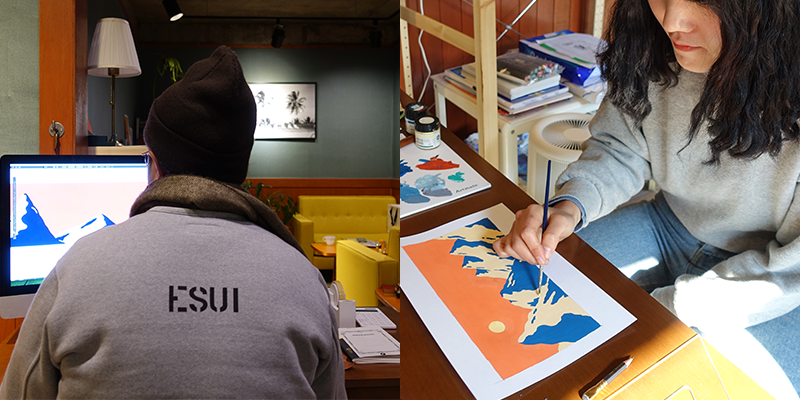
# With MUTEMUSE
- Q. What were your thoughts when you first received the offer to collaborate with MUTEMUSE?
- A. We are actually very careful with deciding on fashion proposals, because we'd rather pass on those done halfheartedly in the process. However, seen from the designs to campaigns and products, MUTEMUSE had a very clear expression of its identity. Although relatively new, MUTEMUSE's commitment to quality and detail drew us, and we thought working together would be a rewarding experience.
- Q. What aspect were you most considerate about throughout the process of the collaboration?
- A. With cups, or other <Les Baguettes Hotel> products, all we had to consider was making them look pretty and making sure they were part of the story. In this case, however, handbags are something people carry around with; simply being pretty wouldn't suffice, so we were very careful with the approach.We were worried about the fact that everyone has their own style and whether it would look different from what we expected when the bag actually became a part of the outfit. Furthermore, a collaboration calls for effort on both sides; both parties should work towards a common direction.
Nowadays, however, collaborations end up being more like commissions and sometimes we are just given directions. Fortunately, we’re satisfied with the results this time around, because we were able to work closely with MUTEMUSE to really develop the project together.
- Q. This seems especially apparent in the two straps - the simple and static <Journey> and <Still Life> with boldly outlined motifs.
- A. Right. Working on two straps turned out to be the right decision. There's a certain contrast between the two that compliments each other. Even the motifs, one is of a scenery from nature, while the other depicts objects from everyday life.

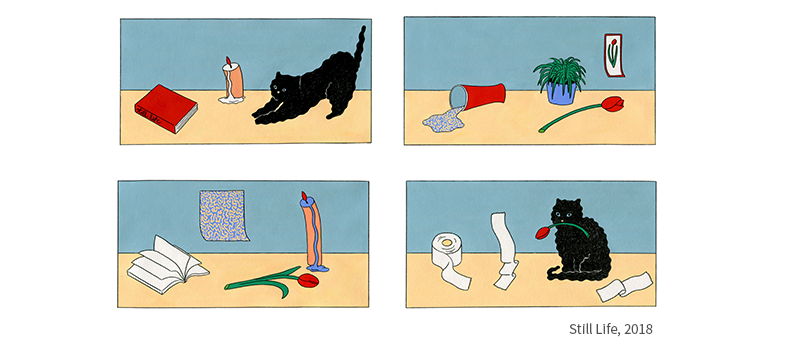
- Q. What are the stories behind the two artworks?
- A. With <Still Life>, we imagined a quiet room.The piece of wallpaper and the spilled cup were intentionally filled with an unrecognizable pattern to allow the viewers to envision whatever is familiar to them. Anything recognizable would be something specific and therefore limit the possibilities. And while the cat isn't a 'still life', he's a static fellow after all.. (laughs)
<Journey> came from the idea of ‘duality of holidays’. The light and shadow cast on the mountain range express the bittersweet nature of holidays. Holidays are exciting, but we never want them to be over. Sometimes you waste time deciding what to do and fail to spend the holidays to their fullest.
- Q. What are some pieces of music that would go well with each strap?
- A. <Still Life> is reminiscent of Oh Ji-eun’s song, ‘Living in Seoul’. There are times when you're exhausted by people, so you find comfort in your belongings. It calms me down to just sit in my room and gaze at the objects. Me, my cat, and the plants are the only ones living and breathing.
<Journey> reminds me of Keith Jarrett's <The Koln Concert> album. All four parts of the concert are improvised. Maybe it's the resemblance between the ridge of the mountain and the fluctuations of sheet music and melodies. I love jazz and I feel that the illustration goes well with its improvisational expressions of the genre.
- Q. Among the other strap designs of MUTEMUSE, which were you drawn to?
- A. We were both drawn to <Bad Girls>. It was surprising to see how good the calligraphy design looked on the strap. Not only was it visually appealing, but it also seems like an effective way to send a message - which is a really cool message, by the way.
- Q. How would you like others to perceive the collaboration between Kimi&12 and MUTEMUSE?
- A. Compared to other collaborations we've done so far, this project with MUTEMUSE was the one where we truly showed our style. If the focus before was to create designs that would compliment the product, we were able to fully express ourselves this time around.
We'd really like it if people recognized our style. Obviously, everyone has a different take on things, so some may disagree. Nevertheless, these designs really represent our style and we hope others feel the same way.
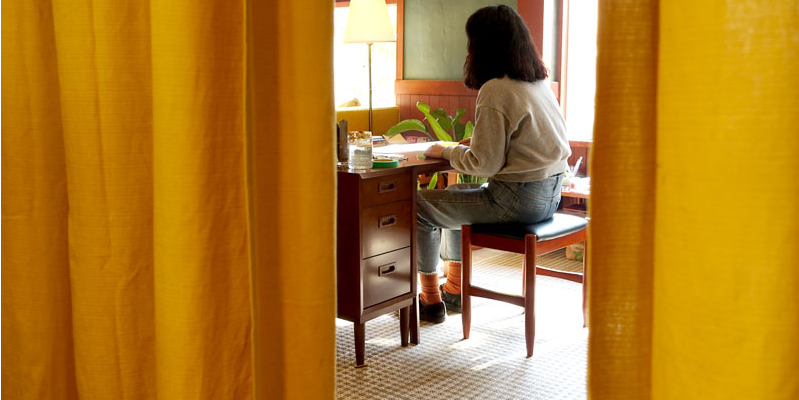
Review
There are no posts to show
Q&A
There are no posts to show











